Out of all the races available to players in 5e, Lizardfolk is one of the most bestial. They are driven almost entirely by their hunger and desire for sustenance. They care little for wealth or knowledge that doesn’t help them in the immediate moment.
This can be a lot of fun to roleplay as a player, while their racial features offer some fun options to incorporate into various builds. So, if you want to play a Lizardfolk adventurer, here a Lizardfolk 5e Guide with everything you need to know.
Key Info Up Front
- Books: Volo’s Guide to Monsters, Mordenkainen Presents: Monsters of the Multiverse
- Editions: 1e, 2e, 3e, 4e, 5e
- Appearance: Humanoid lizard-people with fins running down their head and neck, long tails, and talons on their hands and feet.
Lizardfolk Lore
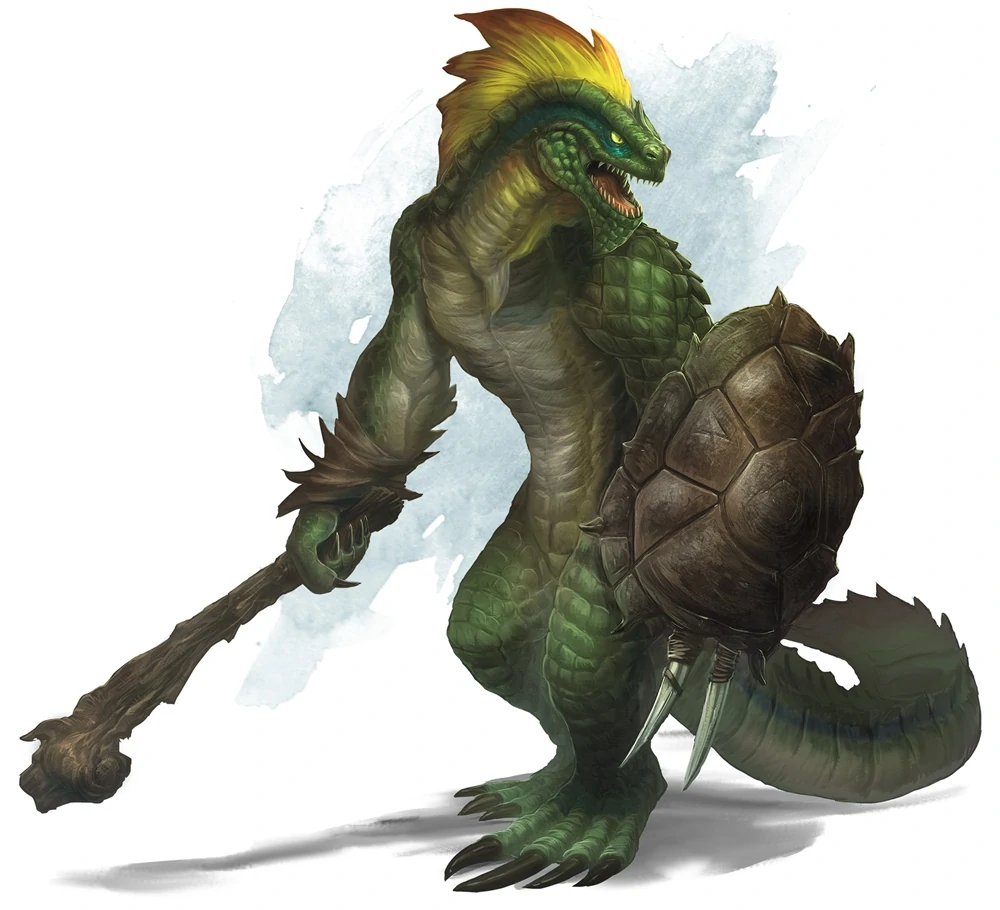
The history of the Lizardfolk can be difficult to trace because they don’t keep any record of it themselves. Instead, they remember essential parts of their background by passing stories down through the generations. At the same time, other elements of their past can be pieced together by references to the Lizardfolk from different cultures. However, combining these two only provides a partial picture.
The Lizardfolk believe that they were the first humanoid species on their home continent of Toril in the Forgotten Realms. They think that they were first born in the swamps of the land and that other species and their advanced civilizations are descended from the Lizardfolk. They think that those other species evolved from the weakest Lizardfolk that couldn’t handle the punishing life in the swamps and set out to make life easier for themselves by founding societies.
Other races believe that Lizardfolk is actually descended from the ancient race known as the Sarrukh. Whichever theory is correct, it seems that the culture of the Lizardfolk is one of the first in the Forgotten Realms, and it has impressively managed to remain essentially unchanged.
Smaller pockets of Lizardfolk were then spread across the lands by first being enslaved by more advanced races. However, they almost always managed to escape their captors and would flee into the nearest swamp to begin their lives anew there. Once they were safely back in the swamps, they proved to be too difficult to recapture in the difficult-to-penetrate terrain, allowing them to live in relative peace once they were free.
Lizardfolk Society
While Lizardfolk balk at more advanced modern societies, they still prefer to group to make their survival easier. Lizardfolk prefer to exist in medium-sized tribal communities within the swamp. These tribes can grow up to 150 members in size and can have various ratios of adults to hatchlings. These tribes tend to be led by males, while any tribe member can challenge the chief to combat for the right to rule. The roles of tribal members are determined by their gender, as males are warriors and lieutenants, and women are responsible for raising young and maintaining the tribal camp.
Their young are given birth to as clutches of eggs that have to be kept warm and protected from predators. Lizardfolk prefer to use the most primitive of weapons imaginable so that they can be fashioned from their surroundings at any time. Hence, their nests are usually little more than bundles of grass or other plants. Their primitive society also keeps them from establishing sources of food through farming or animal husbandry, forcing them to only get food from hunting, fishing, or stealing from others.
With how common it is for Lizardfolk to look down on other races from outside their home swamp, it is no surprise that Lizardfolk rarely ventures outside of their home tribe. If they do, it is usually to gather the information that can be taken back to the chief of their tribe or to hunt large prey that can be brought back to feed their family. Any Lizardfolk that do eventually leave their tribe tend to try and stay in groups with other Lizardfolk out of fear that exposure to civilization will corrupt them and make them lose sight of what they once were.
Lizardfolk tend to worship the lesser deity known as Semuanya, who was once very focused on helping the species survive. Their worship of Semuanya is led by tribal clerics that communicate with their deity through rituals. However, Semuanya eventually turned their back on the Lizardfolk and instead wanted them to survive on their own merits and strength. This led many Lizardfolk to worship nature itself instead and inspired the funeral rites that saw them eating their dead to help the tribe survive.
Lizardfolk Traits
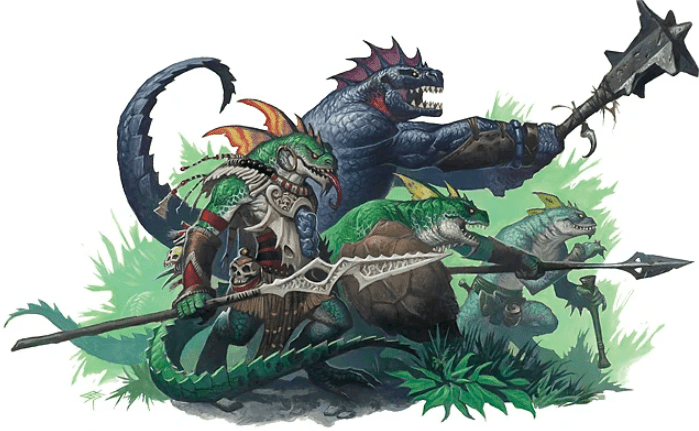
There are two versions of the Lizardfolk that have been officially released in Volo’s Guide to Monsters and Mordenkainen Presents Monsters of the Multiverse. So, if you want to play a Lizardfolk, you have to decide which you want to play, either by its mechanics or whichever book you have available to you. If you aren’t sure, I recommend talking with your Dungeon Master before making your character.
However, there are some similarities between the two. In both releases, Lizardfolk are said to reach maturity around age 14, while they rarely live to see 60 years. However, they tend to grow slightly larger than average humans, giving them a medium size and base walk and swimming speed of 30 feet. They also naturally know both the Common and Draconic languages.
Volo’s Guide to Monsters
In Volo’s Guide to Monsters, Lizardfolk characters start with a Consitution increase of two and a Wisdom increase of one. This reflects their hardy nature as well as their ability to observe and learn the punishing surroundings of their homelands. Their first racial feature is their Bite attack, which can be used in lieu of unarmed strikes. These attacks deal 1d6 + your Strength modifier piercing damage, which is a good upgrade over the usual unarmed strike damage.
They also come with the Cunning Artisan feature, which allows you to cart a shield, club, javelin, or darts out of the corpses of enemies during a short rest. However, you can only use this feature if your character has a blade or set of tools that will work to do so.
Lizardfolk also can hold their breath for up to 15 minutes thanks to their Hold Breath feature. Their Hunter’s Lore feature also gives them a proficiency in two of the following skills: Animal Handling, Nature, Perception, Stealth, and Survival, which is great to help round out your character’s capabilities outside of combat.
Lizardfolk also come with the Natural Armor feature, which gives them a natural armor class equal to 13 + your Dexterity modifier. Even if your character is wearing armor, you can opt to use their Natural Armor rating instead if you decide to.
The final racial feature that Lizardfolk have is called Hungry Jaws. This allows you to make a Bite attack with your bonus action once per short or long rest. If the attack is successful, you also gain temporary hit points equal to your Constitution modifier from the bite of flesh you eat from the target.
Mordenkainen Presents: Monsters of the Multiverse
With the release of Mordenkainen Presents: Monsters of the Multiverse, the Lizardfolk got a rework for players that want to play them. The first change is the removal of their Cunning Artisan feature. Their Bite attack was also changed to deal slashing damage instead of piercing while also being considered a normal unarmed attack instead of a natural weapon.
The Hunter’s Lore feature was also changed to Nature’s Intuition, which gives the Lizardfolk the ability to choose two of the following skill proficiencies: Animal Handling, Nature, medicine, Perception, Stealth, and Survival.
Finally, their Hungry Jaws trait was also improved to be used several times equal to your character’s proficiency bonus per long rest as well as the temporary hit points gained are similar to your proficiency bonus rather than your Constitution modifier.
Roleplaying a Lizardfolk
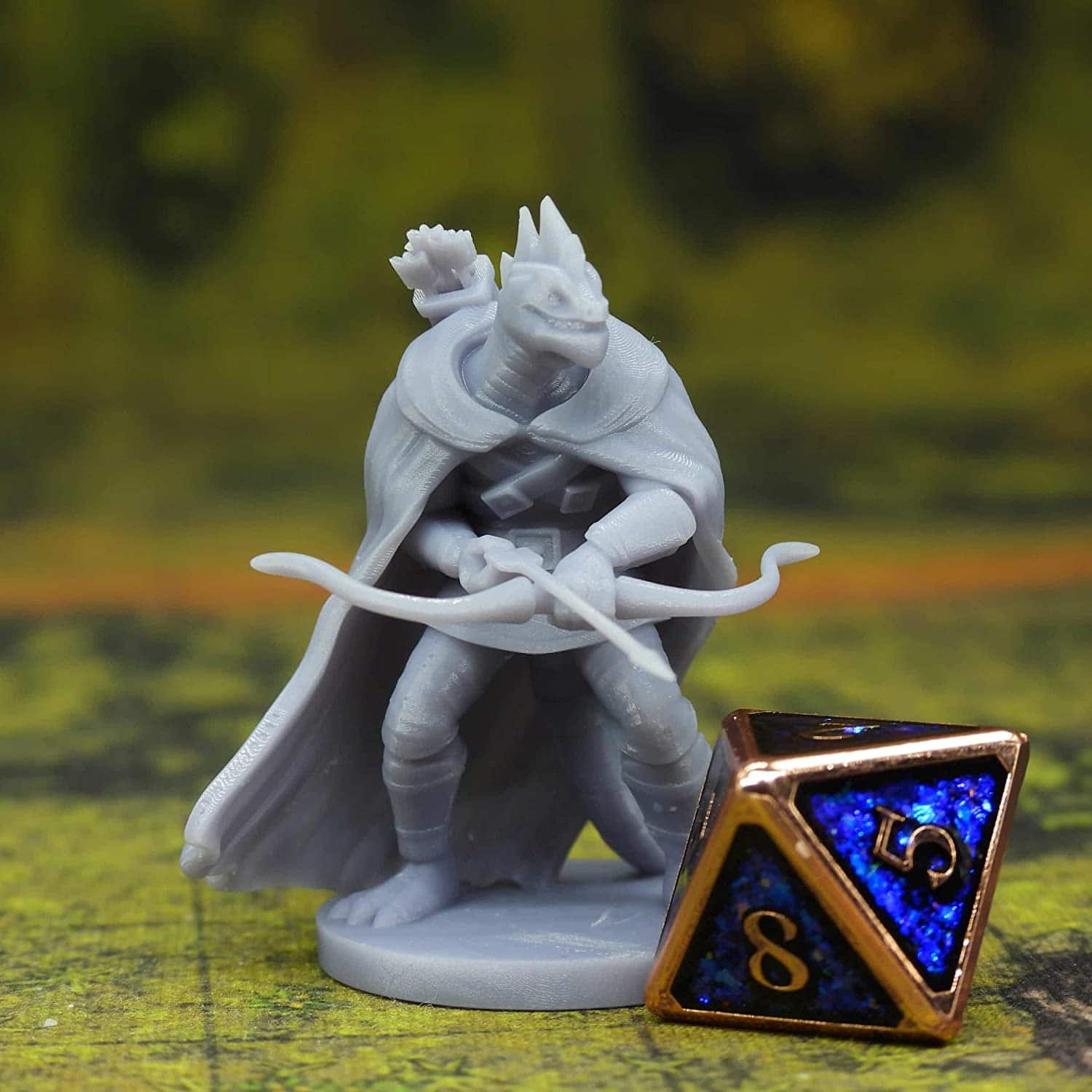
The most exciting part of playing a Lizardfolk in 5e isn’t the mechanical aspects of the race to me, but rather the unique roleplaying implications of the race caries. With how secluded Lizardfolk grow up in their swamps, your character will be amazed by most of what they come across during their adventures, How they react to these discoveries will depend on how you want to play them, as they can both find them foolish and weak, or could be amazed at what their tribe is missing.
Of course, you’ll also have to figure out what motivated your Lizardfolk to leave their tribe behind since it is so rare for them to do so. There are numerous ways that you can go about doing so, whether it be a great tragedy pushing them away from their tribe, trying to find something in the broader world that they need, like a cure for a disease, or even just a youthful wanderlust that sees them rejecting their racial culture.
While you roleplay your Lizardfolk, you’ll also want to keep in mind what motivates their actions. Since Lizardfolk are typically driven by little more than hunger and their immediate needs, it can be a lot of fun to roleplay a character that doesn’t care about money or other rewards. However, you should be careful to not let this directly conflict with your party’s interests, as that will make your character less fun for everyone else to play with.
To do so, I recommend having your Lizardfolk not be swayed by wealth or knowledge that they would find useless, but avoid having that drive them to go against the party or not play well with their party members.
Best Lizardfolk Classes
Druid

Druids are a natural fit for Lizardfolk both mechanically and when considering the flavor of the class and race. Lizardfolk tribes have a very close relationship with the swamps that they call home and, as such, are very well known to begin worshipping nature itself.
Mechanically, the Lizardfolk is an excellent fit for a Druid, regardless of which version you opt to use. The custom ability score increases in Mordenkainen’s is slightly better so that you can get more out of them.
Still, either way, the Lizardfolk’s Natural Armor will be better than most armor Druids have access to.
Druid Subclasses
- Circle of Dreams (Xanathar’s Guide to Everything): This Druid subclass is focused on expanding the class’ utility and support options. However, most of its features aren’t very strong, and it fails to fulfill the support role as well as other options like Clerics. Its flavor also doesn’t work with a Lizardfolk very naturally, but you can backstory your way around that.
- Circle of Spores (Guildmasters’ Guide to Ravnica/Tasha’s Cauldron of Everything): This subclass is perfect for the Lizardfolk. It is a solid offensive route to take, which meshes very well with their hunger-driven temperament as well as its flavor of spores working well with their swamp homelands.
- Circle of Stars (Tasha’s Cauldron of Everything): This subclass enhances the Druid’s offensive and healing capabilities while having some great decision points that allow players to react to situations well. It also beefs up their spellcasting abilities, allowing them to operate more in line with more powerful casters like Wizards and Sorcerers.
- Circle of Wildfire (Tasha’s Cauldron of Everything): This Druid subclass has some exciting flavor, with those who follow it valuing the natural role that destruction plays in life. It is very reliant on fire damage, but outside of that, it has some fun options, and it can make sense for a lizardfolk to follow that line of thinking.
- Circle of the Land (Player’s Handbook): If you want to play a Druid that has wild shapes sometimes but spends most of its time casting spells, this is the option for you. It is a relatively specific subclass and is a great way to be introduced to playing a spellcaster in 5e.
- Circle of the Moon (Player’s Handbook): Circle of the Moon focuses on improving the Druid’s Wildshape feature, allowing it to be used as a strong combat ability. If you love the idea of turning into different animals, follow this route to get the most out of it possible.
- Circle of the Shepherd (Xanathar’s Guide to Everything): This subclass is a summoning-focused support class. While it has some entertaining features and is capable in its own right, it doesn’t fit very well with a Lizardfolk, to me. If that doesn’t bother you, however, this is a good option.
Monk
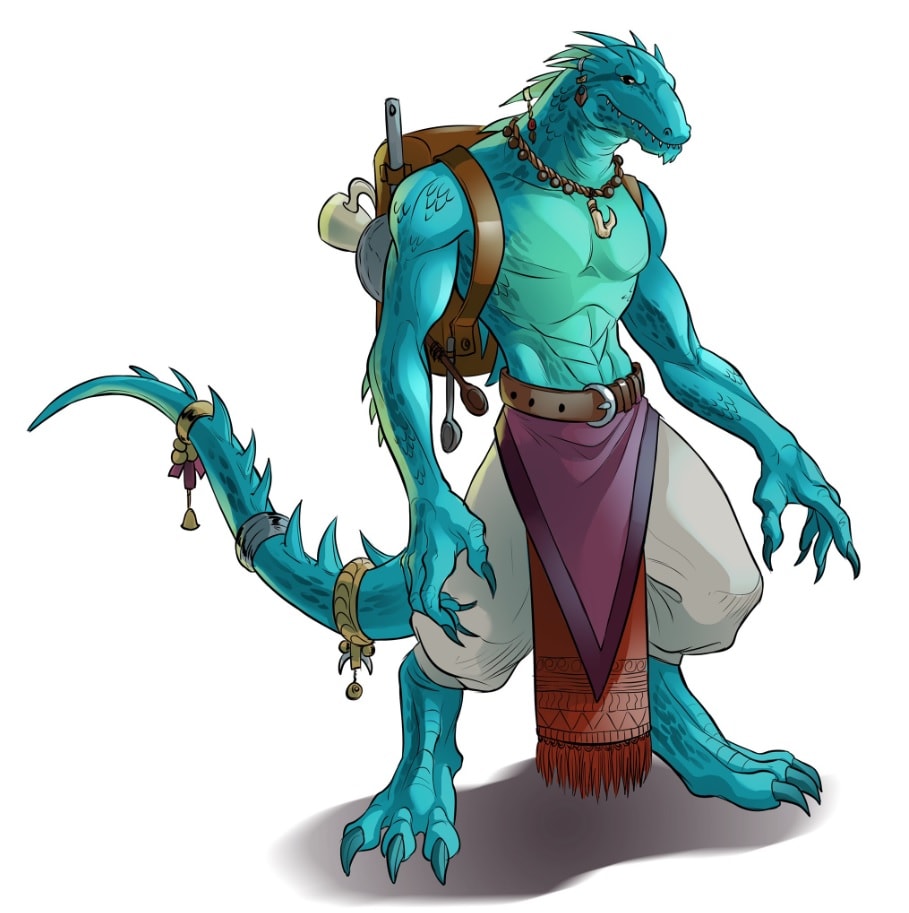
Playing a Lizardfolk Monk is a great way to get around the racial’s preference toward using extremely primitive weaponry. The increased unarmed damage of Monks will negate the benefits of the Lizardfolk’s Bite slightly, but it is still a decent option to get some hit points back with your bonus action.
The two free skill proficiencies are also a good resource for helping you overcome the skill gap that is between Rogues and Monks, making for a very well-rounded character.
Monk Subclasses
- Way of Mercy (Tasha’s Cauldron of Everything): This subclass adds some healing options to the Monk class that can be applied to both yourself and your allies. The subclass works exceptionally well, and it pairs nicely with the added survivability given to the Monk by the Lizardfolk’s Natural Armor.
- Way of Shadow (Player’s Handbook): This subclass tries to turn the Monk into a Rogue-like stealth killer. It has some very flashy features and mechanics, but I find it hard to recommend this subclass over simply playing a Rogue unless you love its flavor.
- Way of the Ascendant Dragon (Fizban’s Treasury of Dragons): If your party is looking for a member to bring crowd control to the table, this is the Monk subclass for you. Not only does it help adapt the Monk into a Blaster character, but it also helps them deal with hordes of smaller enemies on top of shelling out more extensive damage to ones with higher hit point pools. The following of a dragon is also a compelling idea for why your Lizardfolk character left their tribe behind.
- Way of the Astral Self (Tasha’s Cauldron of Everything): The Way of the Astral Self subclass is focused on playing around with a combat buff that summons an astral self to help your character shell out the damage. It has some fascinating ideas, but it also has some glaring gaps in its kit that you should make sure other party members have covered.
- Way of the Drunken Master (Xanathar’s Guide to Everything): The Way of the Drunken Master subclass doesn’t require your character to be drunk or even pretend to be, but it does highlight the Monk’s capability for hit-and-run tactics. However, these tactics don’t mesh particularly well with the more bestial nature of Lizardfolk.
- Way of the Four Elements (Player’s Handbook): I only recommend picking this subclass if you are an experienced 5e player. It has a ton of exciting options and has the potential to be very effective, but that comes with numerous traps and pitfalls that you have to be careful to avoid while building your character.
- Way of the Kensei (Xanathar’s Guide to Everything): The Kensei Monk focuses on adapting martial weapons into the fighting style of the Monk. This subclass is almost entirely outdone by the optional Monk rules in Tasha’s Cauldron of Everything and doesn’t fit well with the very primitive rules of the Lizardfolk, so I recommend skipping this one for now.
- Way of the Long Death (Sword Coast Adventurer’s Guide): This subclass restricts the Monk to fulfilling a Defender role on the battlefield with very few other options. It fills its desired role exceptionally well, but if you’re looking for a variety or more options, this isn’t the choice for you.
- Way of the Open Hand (Player’s Handbook): The Open Hand subclass is the default Monk subclass that focuses on emphasizing the core components of its identity. Still, it brings some fun utility to the table and does an excellent job of being strong, if straightforward.
- Way of the Sun Soul (Sword Coast Adventurer’s Guide): I have a tough time recommending this subclass because of just how poorly focused it is. It attempts to make the Monk a ranged build, and its features are very resource-light, but it is exceptionally weak without constantly using features, which you can only keep running for so long.
Sorcerer (Mordenkainen Presents: Monsters of the Multiverse Version)
If you’re using the version of Lizardfolk from Mordenkainen Presents: Monsters of the Multiverse, then Sorcerer is another excellent option. This is for two main reasons. The first is the two free skill proficiencies that will allow your character to use more than just Face skills when not in combat.
This can be a great way to add some variety to your character and to cover weaker parts of your party. The second is how Hungry Jaw and the Lizardfolk’s Natural Armor are both excellent improvements to the Sorcerer’s durability without having to take up spell slots that can instead be used offensively.
Sorcerer Subclasses
- Aberrant Mind (Tasha’s Cauldron of Everything): The Aberrant Mind is a psionic-themed Sorcerer subclass that is extremely capable in all areas of the battlefield. Its flavor of attacking the minds of targets doesn’t fit a Lizardfolk very well to me, but you can always work around that if the subclass seems like it would be fun.
- Clockwork Soul (Tasha’s Cauldron of Everything): The Clockwork Soul Sorcerer is a fan of order, mechanical consistency, and avoiding the unexpected. It is a fairly strong subclass, but it directly conflicts with the nature of Lizardfolk, so you’ll have to account for that when making your character’s backstory.
- Divine Soul (Xanathar’s Guide to Everything): This subclass is for any sorcerer that wants to worship a divine figure and gives the player access to the Cleric spell list. This subclass comes with some entertaining roleplay possibilities while also boasting a spell list that can handle any problem magic is capable of solving in 5e.
- Draconic Bloodline (Player’s Handbook): The Draconic Bloodline subclass works very well with the appearance and possible lineage of the Lizardfolk. Mechanically, it also has some fun choices to customize it to your tastes, but it does rely heavily on elemental damage.
- Shadow Magic (Xanathar’s Guide to Everything): If your campaign is going to feature a lot of dungeon delving or other dark environments, the Shadow Magic Sorcerer is a great choice. Its features are all compelling and fun to play with as long as you can stay in the darker areas of the world.
- Storm Sorcerer (Sword Coast Adventurer’s Guide/Xanathar’s Guide to Everything): This subclass has a lot of really great thematic and flavor elements to it, but it is challenging to make work. It relies heavily on hit-and-run tactics that won’t work in some combat encounters, and Lizardfolk isn’t particularly well suited to that kind of gameplay either.
- Wild Magic (Player’s Handbook): This subclass is excellent if you’re okay with a healthy bit of randomness in your game. This subclass represents your character not having a handle on their innate magical ability, which fits very well with the simpler nature of Lizardfolk. However, you should check with your party members to make sure they are okay with the chaotic nature of this subclass, as there is a good chance they will bear some of the burden of your negative magic surge effects.
Ranger (Volo’s Guide to Monsters Version)
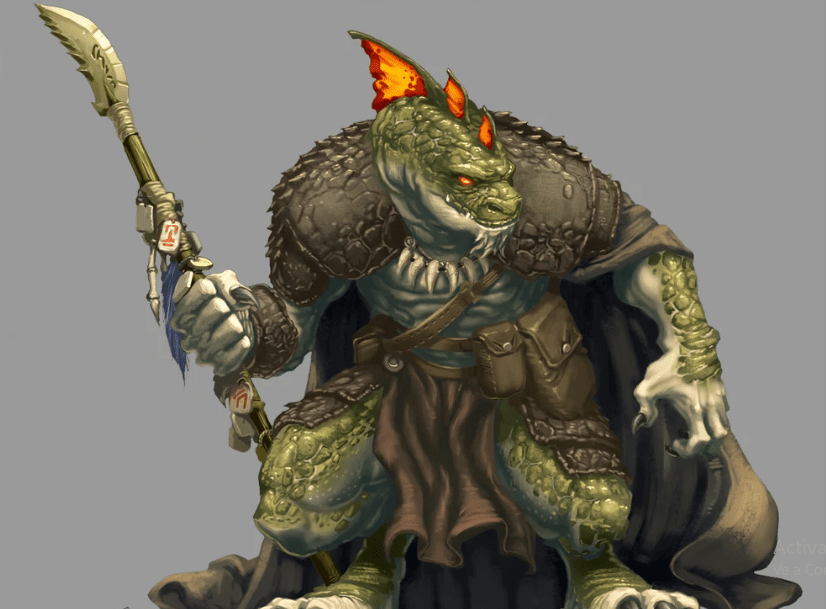
If you’re instead using the Volo’s version of the Lizardfolk, your character will also mesh very naturally with a Ranger. Not only do the Lizardfolk’s skill proficiencies align nicely with the Ranger’s, but their Natural Armor is also better than most armors available to Rangers once they maximize their Dexterity.
Hungry Jaws likely won’t be a strong combat option if you go down this route, but it does offer an inexpensive way to heal outside of combat, especially if you keep a bag of rats with you at all times. Playing a Ranger as a Lizardfolk also makes a lot of sense, as your character could have learned their methods while acting as a hunter for their tribe.
Ranger Subclasses
- Beast Master (Player’s Handbook): This subclass is the iconic Ranger subclass that gives them a beast friend that travels along with them. There are a few fun decision points here while also being a very mechanically strong subclass. Having a pet companion is also an excellent way for your Lizardfolk to try and stay in touch with their roots while adventuring around the world.
- Drakewarden (Fizban’s Treasury of Dragons): The Drakewarden functions very similarly to the Beast Master, although it replaces the bestial companion with a Drake. This has some great flavor with playing a Lizardfolk and is a very mechanically capable subclass option.
- Fey Wanderer (Tasha’s Cauldron of Everything): Thie Fey Wanderer is a Ranger that is used to living in the Feywilds plane. It has very powerful features, but it doesn’t mesh well at all with a Lizardfolk that spent most of its life in a swamp.
- Gloom Stalker (Xanathar’s Guide to Everything): The Gloom Stalker is a fantastic subclass option if your campaign takes place in the Underdark or a lot of dungeons. Otherwise, you’re better off skipping this one.
- Horizon Walker (Xanathar’s Guide to Everything): The Horizon Walker Ranger is a master of traveling through the many planes that make up the worlds of 5e. This has some fun story opportunities when playing a Lizardfolk and is an excellent way of describing why they left their tribe behind, as seeing that incredible of a universe would understandably want to adventure out of the swamp.
- Hunter (Player’s Handbook): The Hunter is the default Ranger subclass and focuses on ranged combat and stealth. This works perfectly for any Lizardfolk that were previously hunters for their tribe and are more than capable of holding their own in combat encounters as well.
- Monster Slayer (Xanathar’s Guide to Everything): I only recommend playing the Monster Slayer subclass if the Hunter sounded interesting to you but seemed a tad too complicated. They both fulfill similar roles, but the Monster Slayer is slightly more restricted but simpler.
- Swarm Keeper (Tasha’s Cauldron of Everything): The Swarm Keeper is similar to the Beast Master but commands an entire group of smaller creatures rather than one larger one. It has some great flavor, while its swarms can be customized to various animals, so you can pick one that makes sense for your character to put together in a swamp.
FAQs
Question: Are Lizardfolk playable in 5e?
Answer: Yes, you can find the rules for playing one in either Volo’s Guide to Monsters or Mordenkainen Presents: Monsters of the Multiverse.
Question: Do Lizardfolk make good Druids in 5e?
Answer: Yes, mainly if you use the custom origins rule, allowing you to customize your ability score increases when making a Lizardfolk character.
Question: How do you name a Lizardfolk in 5e?
Answer: Lizardfolk have names like Braza, Crae, Traz, and Saraza, but they are not known to take surnames of any kind.
Conclusion
Playing a Lizardfolk can help you define your character and make them stand out from other characters you have played or even your fellow party members. They have very fun personalities and are a bit challenging to roleplay, and their mechanical features can add some appreciated survivability to any class. So, if playing a Lizardfolk sounds like fun to you, there is little reason not to go for it, and you’ll likely be happy that you chose to play one in the end.
- Steel Defender 5e Guide - September 5, 2022
- Harengon 5e Guide - August 24, 2022
- Shambling Mound 5e Guide: The Most Terrifying Plant - August 21, 2022

